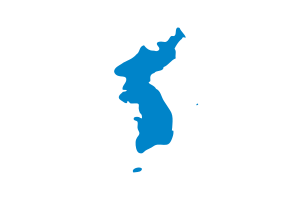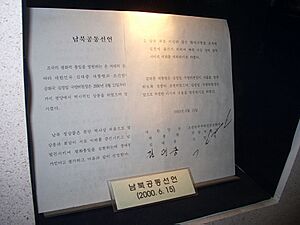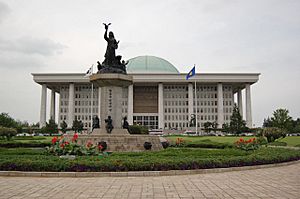Korean reunification facts for kids
| Korean reunification | |

|
|
Quick facts for kids Korean name |
|
|---|---|
| Hangul |
남북통일
|
| Hanja | |
| Revised Romanization | Nambuk Tong(-)il |
| McCune–Reischauer | Nampuk T'ongil |
Korean reunification is the idea of bringing North Korea and South Korea back together. They would become one single country again, called Korea. This process started with important agreements like the June 15th North–South Joint Declaration in 2000. Later, the Panmunjom Declaration in 2018 also aimed for peace.
Before World War II (1939-1945), Korea was one country for many centuries. It was ruled by dynasties like Goryeo and Joseon. But after World War II ended in 1945, Korea was divided. This happened because of the start of the Cold War.
In 1948, Korea split into two countries along the 38th parallel. This line is now the Korean Demilitarized Zone. The Soviet Union occupied North Korea, and the United States occupied South Korea. Both new governments claimed to be the only true government of all Korea. The Korean War began in 1950 and ended in 1953. It was a stalemate, meaning no side truly won.
After the war, reunification became very difficult. The two Koreas grew further apart. Relations improved a little in the early 2000s and late 2010s. South Korea tried a plan called the Sunshine Policy to engage with the North. However, relations have become worse since then. In 2024, North Korean leader Kim Jong Un said he would no longer seek unification. He even tore down the Arch of Reunification in Pyongyang.
Contents
Why Korea Was Divided
The division of Korea happened at the end of World War II. Before this, Japan had ruled Korea since 1910. In 1943, the United States, China, and the United Kingdom agreed that Korea should become free.
In 1945, the United Nations planned to help Korea become independent. But the peninsula was divided into two military zones. The Soviet Union took control of the North. The United States took control of the South. This division was along the 38th parallel. Japanese soldiers north of this line surrendered to the Soviets. Those south of the line surrendered to the Americans.
The division was not meant to last long. But Cold War politics led to two separate governments in 1948. Tensions grew, preventing cooperation. Many Koreans wanted peaceful unification. However, the Korean War broke out in 1950. North Korean troops invaded South Korea. After three years of fighting, the war ended with an armistice. The border stayed almost the same.
Steps Towards Reunification
After the Korean War, there have been several attempts to bring the two Koreas closer.
Early Agreements
North-South Joint Communiqué (1972)
In 1972, North and South Korea tried to improve their relationship. They signed the July 4 South–North Joint Statement. Both sides secretly visited each other's capital cities. They agreed on steps for peaceful reunification:
- Unification should happen by Koreans themselves, without outside help.
- It should be peaceful, without using force.
- They should seek national unity, putting aside differences.
- To ease tensions, they agreed not to criticize each other. They also agreed not to start military actions.
- They would exchange in areas like culture and science.
- They would work together on Red Cross talks.
- A direct phone line would be set up between Seoul and Pyongyang.
- A North-South Coordinating Committee would be formed to solve problems.
However, this committee was soon disbanded. Not much progress was made. Later, in 1990, the prime ministers of both Koreas met. They discussed reconciliation and cooperation. But these talks failed over nuclear inspections.
June 15th North–South Joint Declaration (2000)
In June 2000, North and South Korea signed another important agreement. It was called the June 15th North–South Joint Declaration. Both sides promised to work for peaceful reunification. They agreed to:
- Solve the reunification question independently.
- Work together on ideas for reunification, as their proposals were similar.
- Solve humanitarian issues quickly. This included exchanging visits for separated families.
- Develop their economies through cooperation. They also aimed to build trust through exchanges in many fields.
- Hold official talks soon to put these points into action.
October 4th Declaration (2007)
In 2007, leaders from North and South Korea met again. They signed the October 4th Declaration. This agreement aimed to improve relations further. Key points included:
- Upholding the June 15 Joint Declaration.
- Changing relations to mutual respect and trust.
- Working together to end military hostility and ensure peace.
- Cooperating to end the armistice and build lasting peace. They wanted a meeting of leaders from countries involved in the war.
- Restarting economic cooperation for shared benefit.
- Developing exchanges in social and cultural fields.
- Pushing forward humanitarian cooperation.
- Strengthening cooperation on the international stage.
Panmunjom Declaration (2018)
In April 2018, Kim Jong Un and Moon Jae-in met at Panmunjom. They signed the Panmunjom Declaration. They declared that war would no longer exist on the Korean peninsula. They aimed for a new era of peace. The main points were:
- Improving North-South ties greatly. This would reconnect the nation and bring common prosperity.
- Working together to reduce military tensions. They wanted to lower the risk of war.
- Cooperating to build a lasting peace system on the Korean peninsula.
International Efforts
Sometimes, North and South Korea have joined forces in sports. A unified Korean team marched in the opening ceremonies of the 2000 Summer Olympics, 2004 Summer Olympics, and 2006 Winter Olympics. However, they competed separately in the games. In 1991, they formed a unified team for the 1991 World Table Tennis Championships. At the 2018 Winter Olympics, a unified women's ice hockey team competed.
Current Situation
The way unification might happen is still a big debate. It could be through one side collapsing, or by forming a united federation. Many countries are interested in this, including China, Japan, Russia, and the United States.
Relations between the two Koreas have been difficult. There have been conflicts, like the sinking of a South Korean warship in 2010. North Korea has also conducted rocket launches and nuclear tests.
Reunification remains a long-term goal for both governments. In 2012, Kim Jong Un called for removing confrontation. He wanted to increase economic and political cooperation. South Korea's Ministry of Unification also works to raise awareness about reunification. They use educational programs and textbooks.
Recent Peace Efforts (2018–2019)
In 2018, Kim Jong Un suggested North Korea participate in the 2018 Winter Olympics in South Korea. This was a big change after years of tension. The two Koreas marched together with a unified flag at the opening ceremony. They also formed a unified ice hockey team.
In April 2018, Kim Jong Un and South Korean President Moon Jae-in met. They agreed to work towards peace by the end of the year. Both leaders crossed each other's borders. Kim also said North Korea would start denuclearization. This was supported by then-U.S. President Donald Trump. In 2019, Moon Jae-in even suggested reunification by 2045. However, these peace talks did not lead to lasting change. North Korea continued its nuclear program.
North Korea's New Stance (2024)
In December 2023, Kim Jong Un said North Korea would change its approach to South Korea. He called South Korea an "enemy." He stated that reunification could never happen with South Korea. He said their goal of "unification by absorption" was against North Korea's idea of "one nation, one state with two systems."
Kim mentioned that South Korea's constitution claims all of the Korean Peninsula. He also pointed to South Korean President Yoon Suk Yeol's policies. Kim said the two Koreas are now "hostile states." He ordered changes to organizations dealing with inter-Korean relations.
In January 2024, Kim confirmed this policy shift. He called for changes to North Korea's constitution. These changes would remove references to cooperation and reunification. They would also define North Korea's borders. He said that any invasion, even tiny, would be an act of war. He also called for the removal of physical symbols like the Arch of Reunification. This arch was later demolished.
In response, South Korea plans to update its vision for unification. This new vision will include the principle of liberal democracy. This will be the first revision of South Korea's unification policy since 1994.
Strategies for Unification
Over the years, different ideas have been proposed for how to achieve reunification.
Sunshine Policy
South Korea's President Kim Dae-jung introduced the Sunshine Policy. This plan aimed to create economic help and cooperation with North Korea. It avoided sanctions and military threats. The plan had three parts:
- More cooperation between North and South, while keeping separate systems.
- National unification with two self-governing regions.
- Finally, creating one central national government.
In 1998, Kim Dae-jung sent food aid to North Korea. He also made it easier for businesses to deal with North Korean firms. In 2000, the leaders of North and South Korea met for the first time since the division.
However, the Sunshine Policy was later seen as a failure by South Korea. This was mainly because of North Korea's nuclear weapons program.
Criticism of the Sunshine Policy
Some people argued that the Sunshine Policy did not help peaceful reunification. They believed that giving money to North Korea only helped its government stay in power. Others thought South Korea should always be ready for a North Korean attack. Some hardliners believed that isolating North Korea would lead to its collapse. Then, South Korea could take over the territory by force.
In the early 2000s, relations worsened. The U.S. government labeled North Korea as part of an "axis of evil." North Korea then left a nuclear agreement and restarted its nuclear program. By 2005, North Korea confirmed it had become a nuclear-armed state.
North Korea's Three Charters for National Reunification
In North Korea, the Three Charters for National Reunification guide their approach. These include:
- The Three Principles of National Reunification.
- The Ten Point Programme for Reunification of the Country.
- The plan for a Democratic Confederal Republic of Koryo.
Three Principles for National Reunification
North Korean President Kim Il Sung proposed these principles in 1972. They are:
- Reunification should happen independently, without outside interference.
- Great national unity should be promoted, despite different ideas.
- Reunification should be achieved peacefully, without using weapons.
Ten Point Programme for Reunification of the Country
Kim Il Sung wrote this program in 1993. It talks about reunifying under a unified state. It again stresses independent reunification. It also calls for the removal of U.S. forces from the peninsula. Key points include:
- Founding a unified, independent, peaceful, and neutral state.
- Unity based on patriotism and national independence.
- Unity for common interests and reunification.
- Stopping political disputes that cause division.
- Overcoming fears of invasion and trusting each other.
- Working together despite different systems.
- Using wealth for national unity.
- Building understanding through contacts and talks.
- Strengthening solidarity among all Koreans.
- Honoring those who help national unity.
Plan for the Democratic Confederal Republic of Koryo
In 1980, Kim Il Sung proposed a state called the Democratic Confederal Republic of Koryo (DFRK). This would be a confederation where North and South Korea would keep their own political systems at first. North Korea describes it as a peaceful proposal. It would be a neutral country, not joining any military alliances.
Other Ideas for Reunification
Reunification Tax (2011)
In 2011, some South Korean lawmakers proposed a "unification tax." This tax would help pay for the costs of reunification. Businesses and individuals would pay a small percentage of their taxes towards this fund. This idea gained more support as concerns about sudden unification grew.
Korean Economic Community
Some suggest forming a Korean Economic Community. This could help ease the unification process. It would involve a body to discuss economic projects between the two Koreas.
Reunification Investment Fund
In 2017, a professor named Shepherd Iverson proposed a large investment fund. The idea was to pay North Korean officials to help with a peaceful change of government. This fund would also help the general population after reunification.
See also
 In Spanish: Reunificación de Corea para niños
In Spanish: Reunificación de Corea para niños
- 2018 North Korea–United States Singapore Summit
- 2019 North Korea–United States Hanoi Summit
- 2019 Koreas–United States DMZ Summit
- Inter-Korean summits
- Seoul–Pyongyang hotline
- Korean conflict
- Division of Korea
- Korean Armistice Agreement
- North Korea–South Korea relations
- Panmunjom Declaration
- Korean peace process



